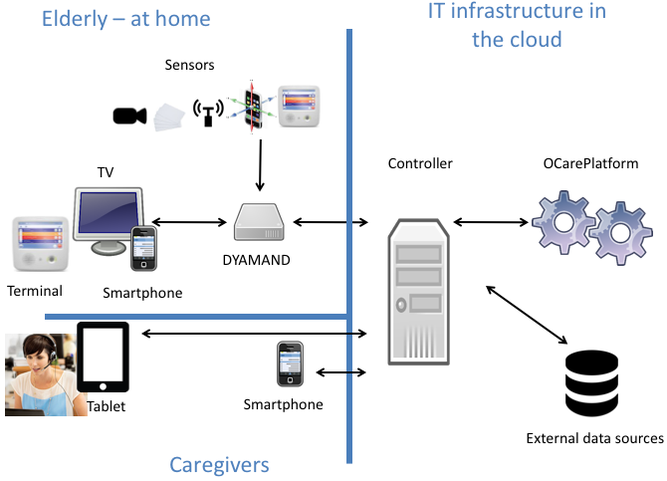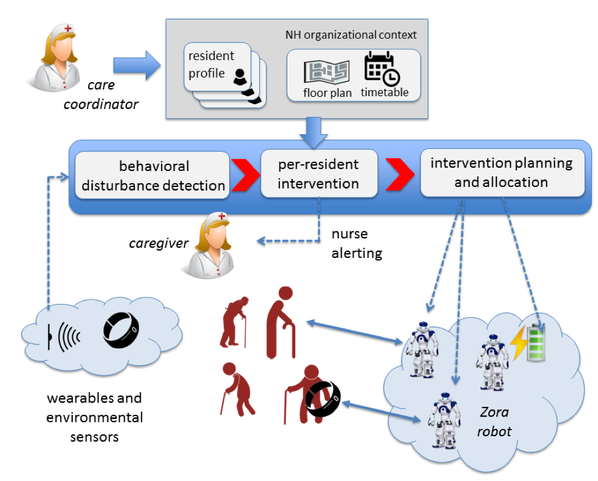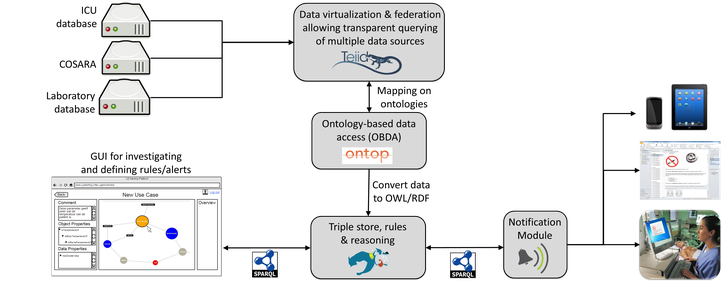Semantic Decision Support
The past years, there has been an increased use of data from sensors on the one hand and external systems on the other hand. Data, which can be used to enhance decisions made by stakeholders in different domains. Examples of such domains are healthcare, both home care and hospital/institutional care, the railway domain, smart cities and smart office/building environments. In order to extract information and knowledge from this multitude of data, semantics techniques are applied.
Our main research objective is to design algorithms and techniques that allow to consolidate all the available data and knowledge in order to offer context-aware and personalized decision support and actionable insights to the end-users.
Specifically, our research efforts focus on the following topics:
- Design of semantic knowledge models for structuring data originating from heterogeneous data sources
- Design of Semantic decision support services and workflows, able to reason on the available data and alert or notify the appropriate stakeholder
- Algorithms and techniques for semantic anomaly detection, root cause analysis and derivations of required actions
- Algorithms for context- & social-aware task scheduling for robotic services
- Particular focus and experience with designing services for intelligent transport, improving and supporting continuous homecare, realizing intelligent hospital information services and smart manufacturing.
- Dynamic and semantic dashboards for decision support and root cause analysis
Staff
Filip De Turck, Femke De Backere, Femke Ongenae, Stijn Verstichel, Erik Mannens, Sofie Van Hoecke.
Researchers
Pieter Bonte, Gilles Vandewiele, Alexander Dejonghe, Jeroen Schaballi, Dörthe Arndt, Ben De Meester, Joachim Van Herwegen, Olivier Janssens.
Projects
- ICON – OCareCloudS: Organizing Care through trusted Cloudy-like Services
- ICON – FallRisk: Social-aware and context-aware multi-sensor fall detection system
- ICON – Trapist: Train Passenger Interfaces for Smart Travel
- ICON – WONDER: interventions for Wandering and Other behavioral disturbaNces of persons with DEmentia in nursing homes by personalized Robot interactions
- IWT VIS SMARTPRO: Smart Textiles and wearable intelligence
- Bilateral Ghent University Hospital on Advanced Alerting System
Key publications
- De Backere, F., Ongenae, F., Vannieuwenborg, F., Van Ooteghem, J., Duysburgh, P., Jansen, A., Hoebeke, J., et al. (2016). The OCareCloudS project: toward organizing care through trusted cloud services. INFORMATICS FOR HEALTH & SOCIAL CARE, 41(2), 159–176.
- De Backere, F., Ongenae, F., Van den Abeele, F., Nelis, J., Bonte, P., Clement, E., Philpott, M., et al. (2015). Towards a social and context-aware multi-sensor fall detection and risk assessment platform. COMPUTERS IN BIOLOGY AND MEDICINE, 64, 307–320.
- Ongenae, F., Myny, D., Dhaene, T., Defloor, T., Van Goubergen, D., Verhoeve, P., Decruyenaere, J., et al. (2011). An ontology-based nurse call management system (oNCS) with probabilistic priority assessment. BMC HEALTH SERVICES RESEARCH, 11.
- Verstichel, S., Kerckhove, W., Dupont, T., Volckaert, B., Ongenae, F., De Turck, F., & Demeester, P. (2015). LimeDS and the TraPIST project: a case study. 7e International Joint Conference on Knowledge Discovery, Knowledge Engineering, and Knowledge Management, Proceedings (Vol. 2 KEOD, pp. 501–508). Presented at the 7e International Joint Conference on Knowledge Discovery, Knowledge Engineering, and Knowledge Management (IC3K 2015).
- F. Ongenae, F. De Backere, J. Nelis, S. De Pestel, C. Mahieu, S. Elprama, C. Jewell, A. Jacobs, P. Simoens, and F. De Turck, Personalized robot interactions to intercept behavioral disturbances of people with dementia, Accepted for ISWC 2016
- De Backere, F., Moens, H., Steurbaut, K., COLPAERT, K., Decruyenaere, J., & De Turck, F. (2012). Towards automated generation and execution of clinical guidelines: engine design and implementation through the ICU Modified Schofield use case. COMPUTERS IN BIOLOGY AND MEDICINE, 42(8), 793–805.
- Ongenae, F., GADEYNE, B., De Backere, F., De BUs, L., Depuydt, P., Decruyenaere, J., & De Turck, F. (2015). Digital Dr. House: A semantic alerting platform for the ICU. Semantic Web Applications and Tools for Life Sciences International Conference (pp. 1–2). Presented at the Semantic Web Applications and Tools for Life Sciences International Conference (SWAT4LS).
- Van Hoecke, Sofie, Ruben Verborgh, Davy Van Deursen, and Rik Van de Walle. 2014. “SAMuS: Service-oriented Architecture for Multisensor Surveillance in Smart Homes.” Scientific World Journal.
- Van Hoecke, Sofie, Cynric Huys, Olivier Janssens, Ruben Verborgh, and Rik Van de Walle. 2015. “Dynamic Monitoring Dashboards Through Composition of Web and Visualisation Services.” In 2nd EAI International Conference on Software Defined Wireless Networks and Cognitive Technologies for IoT, ed. Imrich Chlamtac. SpringerLink: Springer.


